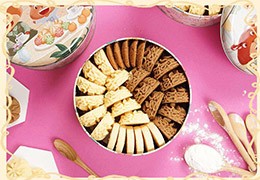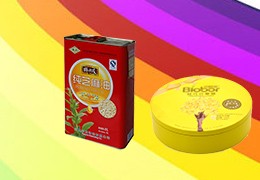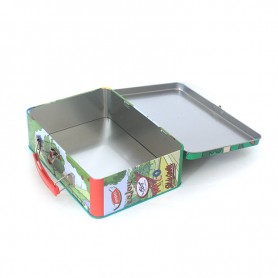أصبحت عبوات علب...
Precautions for purchasing metal lunch box for kids
Time flies like arrows, and the sun and the moon flies. Maybe the child held a baby bottle to drink milk a moment ago, and then started to go to school. The child grows up and needs his own metal lunch box, so how should I choose these children's tableware?
At present, the common metal lunch boxes for kids on the market are mainly tinplate lunch boxes, aluminum lunch boxes, and stainless steel lunch boxes. Among them, the tinplate lunch box mainly refers to the lunch box made of tin-plated iron. Today I will introduce your selection method and precautions in use.

The risks of stainless steel lunch boxes
The stainless steel kids lunch box has its unique advantages, such as drop resistance, corrosion resistance, easy cleaning, not easy to residual odor, low chemical elements, not easy to breed bacteria and so on. But everything has two sides. Stainless steel tableware also has a heavier weight, strong thermal conductivity, which is easy to burn to the skin, and there is a risk of heavy metal elements moving out. In order to reduce the risk of using it, it is very important to master the selection method of stainless steel lunch boxes.
The raw materials used in the stainless steel lunch box should be food-grade stainless steel, and its heavy metal migration and other indicators should comply with the relevant regulations in GB4806.9-2016 "National Food Safety Standard for Food Contact Metal Materials and Products". At present, food-grade 430, 304 and 316 stainless steel materials are mainly used to make lunch boxes, and the most common is food-grade 304 stainless steel.

The correct selection method of stainless steel lunch box
01. You should buy from regular channels, and try to choose the metal lunch box for kids produced by brand manufacturers. Don't buy it at street stalls for cheap, which will be more secure.
02. Pay attention to whether the metal lunch box for kids has the corresponding label. For example, 304 stainless steel used for food contact should be marked in a conspicuous position. At the same time, check whether it has manufacturer information, manuals, qualification certificates, etc., and do not buy Sanwu products.
03. Check the appearance and weight of the metal lunch box for kids. The surface of the stainless steel lunch box with a good quality should be smooth and free of cracks and other abnormal phenomena. In addition, metal lunch boxes are relatively heavy, and children may be very laborious when holding them, so you should try to choose lighter-weight tableware.

Precautions for using metal lunch box for kids
1. The stainless steel lunch box for kids is heavier, and it is easy for children to hold it unsteadily, especially for children under the age of 6-7. Therefore, younger children should try their best to have parents guarded when using this type of tableware.
2. The stainless steel kids lunch box has strong thermal conductivity and is easy to scald the children's skin, so be careful not to touch the metal surface when using it. But now there are stainless steel lunch boxes with heat insulation function on the market, and parents can choose this kind of lunch box.
3. Stainless steel children’s lunch boxes should not contain foods containing salt, soy sauce, vinegar and other seasonings for a long time, because this will easily cause heavy metal elements in children’s lunch boxes, such as lead, cadmium, chromium, etc., to migrate into the food, which is good for children’s health Cause harm.
Types of kids lunch boxes
①Plastic children's lunch box
You can choose a plastic lunch box for kids, but you must look for the PP material. In addition, because PP is not wear-resistant, you should use a soft cloth when cleaning it, not a wire ball or brush.
Moreover, the heat-resistant temperature of PP is only over 100 degrees, and it cannot be used to hold hot food such as hot oil, and try not to directly use it for steaming.

② Melamine kids lunch box
In theory, a regular and qualified melamine lunch box for children is relatively safe. The low-priced imitation porcelain children’s lunch boxes sold by small vendors are the hardest hit area. They are glamorous and beautiful, but they are definitely not available for purchase. In addition, the melamine children’s lunch box cannot be placed in the microwave oven. Do not scratch the tableware with metal tableware and kitchen utensils.

③Silicone kids lunch box
Silicone is not plastic, but rubber. It is not easy to chemically react with foreign substances. Nowadays, many children's products are made of silicone, such as pacifiers, children's lunch boxes, placemats, etc. You must choose 100% food-grade silicone children's lunch boxes A good silicone product will not change color when it is twisted. If there are white traces, it means that the silicone is not pure and filled with other materials. Don't buy it.
④metal lunch box for kids
Kids lunch boxes made of food-grade tinplate do not ooze heavy metals. Laboratory tests use 5% sulfuric acid. The corrosiveness is much stronger than vinegar and fruit juice, so there is no need to worry about it.
Higher-grade tinplate has stronger corrosion resistance, and is generally used for medical equipment or kids lunch boxes. There are also low-quality tinplate lunch boxes, such as the 200-grade ones, which are definitely not available for purchase.
⑤Ceramic kids lunch box
The ceramic itself is safe, and the unsafe area is the glaze used for inferior ceramics, which may contain heavy metals such as lead and cadmium.
High-quality ceramic tableware is very safe, but there is a disadvantage that it is fragile, so you must never take the ceramic children’s lunch box to children to take to school. The broken pieces of ceramics are very dangerous!
![]()
⑥Glass kids lunch box
The glass does not chemically react with food, nor does it leak toxic substances, it is hard, very safe, and easy to clean. Glass has uniform manufacturing standards. As long as it is a qualified glass kids lunch box, it can be used with confidence.
To pay attention to healthy eating, children’s lunch boxes must be disinfected frequently in a sterilizer, and physical sterilization at medium temperature and ultraviolet rays protects children’s health.




.jpg)













Latest comments